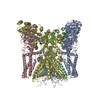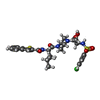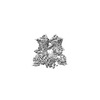+ Open data
Open data
- Basic information
Basic information
| Entry |  | |||||||||
|---|---|---|---|---|---|---|---|---|---|---|
| Title | GSK101 bound state of mTRPV4 | |||||||||
 Map data Map data | ||||||||||
 Sample Sample |
| |||||||||
 Keywords Keywords | mTRPV4 /  STRUCTURAL PROTEIN / STRUCTURAL PROTEIN /  MEMBRANE PROTEIN MEMBRANE PROTEIN | |||||||||
| Function / homology |  Function and homology information Function and homology informationstretch-activated, monoatomic cation-selective, calcium channel activity / blood vessel endothelial cell delamination / osmosensor activity / vasopressin secretion / positive regulation of striated muscle contraction / calcium ion import into cytosol / positive regulation of macrophage inflammatory protein 1 alpha production / negative regulation of brown fat cell differentiation / positive regulation of microtubule depolymerization / hyperosmotic salinity response ...stretch-activated, monoatomic cation-selective, calcium channel activity / blood vessel endothelial cell delamination / osmosensor activity / vasopressin secretion / positive regulation of striated muscle contraction / calcium ion import into cytosol / positive regulation of macrophage inflammatory protein 1 alpha production / negative regulation of brown fat cell differentiation / positive regulation of microtubule depolymerization / hyperosmotic salinity response / hypotonic response / cortical microtubule organization / positive regulation of chemokine (C-X-C motif) ligand 1 production / positive regulation of chemokine (C-C motif) ligand 5 production / cartilage development involved in endochondral bone morphogenesis / cellular hypotonic response / regulation of response to osmotic stress / cellular hypotonic salinity response /  TRP channels / osmosensory signaling pathway / multicellular organismal-level water homeostasis / positive regulation of vascular permeability / cellular response to osmotic stress / calcium ion import / positive regulation of monocyte chemotactic protein-1 production / cell-cell junction assembly / response to osmotic stress / TRP channels / osmosensory signaling pathway / multicellular organismal-level water homeostasis / positive regulation of vascular permeability / cellular response to osmotic stress / calcium ion import / positive regulation of monocyte chemotactic protein-1 production / cell-cell junction assembly / response to osmotic stress /  regulation of aerobic respiration / cortical actin cytoskeleton / positive regulation of macrophage chemotaxis / regulation of aerobic respiration / cortical actin cytoskeleton / positive regulation of macrophage chemotaxis /  beta-tubulin binding / diet induced thermogenesis / beta-tubulin binding / diet induced thermogenesis /  microtubule polymerization / alpha-tubulin binding / cytoplasmic microtubule / microtubule polymerization / alpha-tubulin binding / cytoplasmic microtubule /  energy homeostasis / monoatomic cation channel activity / energy homeostasis / monoatomic cation channel activity /  SH2 domain binding / SH2 domain binding /  protein kinase C binding / protein kinase C binding /  filopodium / actin filament organization / calcium ion transmembrane transport / filopodium / actin filament organization / calcium ion transmembrane transport /  adherens junction / positive regulation of JNK cascade / response to insulin / adherens junction / positive regulation of JNK cascade / response to insulin /  calcium channel activity / calcium channel activity /  cilium / ruffle membrane / intracellular calcium ion homeostasis / positive regulation of inflammatory response / positive regulation of interleukin-6 production / calcium ion transport / cilium / ruffle membrane / intracellular calcium ion homeostasis / positive regulation of inflammatory response / positive regulation of interleukin-6 production / calcium ion transport /  actin filament binding / actin filament binding /  glucose homeostasis / negative regulation of neuron projection development / glucose homeostasis / negative regulation of neuron projection development /  lamellipodium / cellular response to heat / lamellipodium / cellular response to heat /  actin binding / actin binding /  growth cone / positive regulation of cytosolic calcium ion concentration / actin cytoskeleton organization / growth cone / positive regulation of cytosolic calcium ion concentration / actin cytoskeleton organization /  microtubule binding / response to hypoxia / positive regulation of ERK1 and ERK2 cascade / microtubule binding / response to hypoxia / positive regulation of ERK1 and ERK2 cascade /  calmodulin binding / apical plasma membrane / calmodulin binding / apical plasma membrane /  focal adhesion / focal adhesion /  lipid binding / positive regulation of gene expression / lipid binding / positive regulation of gene expression /  protein kinase binding / negative regulation of transcription by RNA polymerase II / protein kinase binding / negative regulation of transcription by RNA polymerase II /  cell surface / cell surface /  ATP binding / identical protein binding / ATP binding / identical protein binding /  metal ion binding / metal ion binding /  plasma membrane plasma membraneSimilarity search - Function | |||||||||
| Biological species |   Mus musculus (house mouse) Mus musculus (house mouse) | |||||||||
| Method |  single particle reconstruction / single particle reconstruction /  cryo EM / Resolution: 3.62 Å cryo EM / Resolution: 3.62 Å | |||||||||
 Authors Authors | Zhen WX / Yang F | |||||||||
| Funding support |  China, 1 items China, 1 items
| |||||||||
 Citation Citation |  Journal: Cell Discov / Year: 2023 Journal: Cell Discov / Year: 2023Title: Structural basis of ligand activation and inhibition in a mammalian TRPV4 ion channel. Authors: Wenxuan Zhen / Zhijun Zhao / Shenghai Chang / Xiaoying Chen / Yangzhuoqun Wan / Fan Yang /  | |||||||||
| History |
|
- Structure visualization
Structure visualization
| Supplemental images |
|---|
- Downloads & links
Downloads & links
-EMDB archive
| Map data |  emd_35921.map.gz emd_35921.map.gz | 51.4 MB |  EMDB map data format EMDB map data format | |
|---|---|---|---|---|
| Header (meta data) |  emd-35921-v30.xml emd-35921-v30.xml emd-35921.xml emd-35921.xml | 13.6 KB 13.6 KB | Display Display |  EMDB header EMDB header |
| Images |  emd_35921.png emd_35921.png | 32.8 KB | ||
| Others |  emd_35921_half_map_1.map.gz emd_35921_half_map_1.map.gz emd_35921_half_map_2.map.gz emd_35921_half_map_2.map.gz | 95.3 MB 95.3 MB | ||
| Archive directory |  http://ftp.pdbj.org/pub/emdb/structures/EMD-35921 http://ftp.pdbj.org/pub/emdb/structures/EMD-35921 ftp://ftp.pdbj.org/pub/emdb/structures/EMD-35921 ftp://ftp.pdbj.org/pub/emdb/structures/EMD-35921 | HTTPS FTP |
-Related structure data
| Related structure data |  8j1fMC  8j1bC  8j1dC  8j1hC  8jkmC M: atomic model generated by this map C: citing same article ( |
|---|---|
| Similar structure data | Similarity search - Function & homology  F&H Search F&H Search |
- Links
Links
| EMDB pages |  EMDB (EBI/PDBe) / EMDB (EBI/PDBe) /  EMDataResource EMDataResource |
|---|---|
| Related items in Molecule of the Month |
- Map
Map
| File |  Download / File: emd_35921.map.gz / Format: CCP4 / Size: 103 MB / Type: IMAGE STORED AS FLOATING POINT NUMBER (4 BYTES) Download / File: emd_35921.map.gz / Format: CCP4 / Size: 103 MB / Type: IMAGE STORED AS FLOATING POINT NUMBER (4 BYTES) | ||||||||||||||||||||
|---|---|---|---|---|---|---|---|---|---|---|---|---|---|---|---|---|---|---|---|---|---|
| Voxel size | X=Y=Z: 0.93 Å | ||||||||||||||||||||
| Density |
| ||||||||||||||||||||
| Symmetry | Space group: 1 | ||||||||||||||||||||
| Details | EMDB XML:
|
-Supplemental data
-Half map: #1
| File | emd_35921_half_map_1.map | ||||||||||||
|---|---|---|---|---|---|---|---|---|---|---|---|---|---|
| Projections & Slices |
| ||||||||||||
| Density Histograms |
-Half map: #2
| File | emd_35921_half_map_2.map | ||||||||||||
|---|---|---|---|---|---|---|---|---|---|---|---|---|---|
| Projections & Slices |
| ||||||||||||
| Density Histograms |
- Sample components
Sample components
-Entire : GSK101 bound state of mTRPV4
| Entire | Name: GSK101 bound state of mTRPV4 |
|---|---|
| Components |
|
-Supramolecule #1: GSK101 bound state of mTRPV4
| Supramolecule | Name: GSK101 bound state of mTRPV4 / type: complex / ID: 1 / Parent: 0 / Macromolecule list: #1 |
|---|---|
| Source (natural) | Organism:   Mus musculus (house mouse) Mus musculus (house mouse) |
-Macromolecule #1: Transient receptor potential cation channel subfamily V member 4
| Macromolecule | Name: Transient receptor potential cation channel subfamily V member 4 type: protein_or_peptide / ID: 1 / Number of copies: 4 / Enantiomer: LEVO |
|---|---|
| Source (natural) | Organism:   Mus musculus (house mouse) Mus musculus (house mouse) |
| Molecular weight | Theoretical: 79.61168 KDa |
| Recombinant expression | Organism:   Homo sapiens (human) Homo sapiens (human) |
| Sequence | String: DYKDDDDKWS HPQFEKGGGG SGGSAWSHPQ FEKEFAPAPQ PPPILKVFNR PILFDIVSRG STADLDGLLS FLLTHKKRLT DEEFREPST GKTCLPKALL NLSNGRNDTI PVLLDIAERT GNMREFINSP FRDIYYRGQT SLHIAIERRC KHYVELLVAQ G ADVHAQAR ...String: DYKDDDDKWS HPQFEKGGGG SGGSAWSHPQ FEKEFAPAPQ PPPILKVFNR PILFDIVSRG STADLDGLLS FLLTHKKRLT DEEFREPST GKTCLPKALL NLSNGRNDTI PVLLDIAERT GNMREFINSP FRDIYYRGQT SLHIAIERRC KHYVELLVAQ G ADVHAQAR GRFFQPKDEG GYFYFGELPL SLAACTNQPH IVNYLTENPH KKADMRRQDS RGNTVLHALV AIADNTRENT KF VTKMYDL LLLKCSRLFP DSNLETVLNN DGLSPLMMAA KTGKIGVFQH IIRREVTDED TRHLSRKFKD WAYGPVYSSL YDL SSLDTC GEEVSVLEIL VYNSKIENRH EMLAVEPINE LLRDKWRKFG AVSFYINVVS YLCAMVIFTL TAYYQPLEGT PPYP YRTTV DYLRLAGEVI TLFTGVLFFF TSIKDLFTKK CPGVNSLFVD GSFQLLYFIY SVLVVVSAAL YLAGIEAYLA VMVFA LVLG WMNALYFTRG LKLTGTYSIM IQKILFKDLF RFLLVYLLFM IGYASALVTL LNPCTNMKVC DEDQSNCTVP TYPACR DSE TFSAFLLDLF KLTIGMGDLE MLSSAKYPVV FILLLVTYII LTFVLLLNML IALMGETVGQ VSKESKHIWK LQWATTI LD IERSFPVFLR KAFRSGEMVT VGKSSDGTPD RRWCFRVDEV NWSHWNQNLG IINEDPGK UniProtKB: Transient receptor potential cation channel subfamily V member 4 |
-Macromolecule #2: N-[(2S)-1-{4-[N-(2,4-dichlorobenzene-1-sulfonyl)-L-seryl]piperazi...
| Macromolecule | Name: N-[(2S)-1-{4-[N-(2,4-dichlorobenzene-1-sulfonyl)-L-seryl]piperazin-1-yl}-4-methyl-1-oxopentan-2-yl]-1-benzothiophene-2-carboxamide type: ligand / ID: 2 / Number of copies: 4 / Formula: XQ3 |
|---|---|
| Molecular weight | Theoretical: 655.613 Da |
| Chemical component information |  ChemComp-XQ3: |
-Experimental details
-Structure determination
| Method |  cryo EM cryo EM |
|---|---|
 Processing Processing |  single particle reconstruction single particle reconstruction |
| Aggregation state | particle |
- Sample preparation
Sample preparation
| Concentration | 5 mg/mL |
|---|---|
| Buffer | pH: 8 |
| Vitrification | Cryogen name: ETHANE |
- Electron microscopy
Electron microscopy
| Microscope | FEI TITAN KRIOS |
|---|---|
| Electron beam | Acceleration voltage: 300 kV / Electron source:  FIELD EMISSION GUN FIELD EMISSION GUN |
| Electron optics | Illumination mode: FLOOD BEAM / Imaging mode: BRIGHT FIELD Bright-field microscopy / Nominal defocus max: 1.6 µm / Nominal defocus min: 0.8 µm Bright-field microscopy / Nominal defocus max: 1.6 µm / Nominal defocus min: 0.8 µm |
| Image recording | Film or detector model: FEI FALCON IV (4k x 4k) / Average electron dose: 52.0 e/Å2 |
| Experimental equipment |  Model: Titan Krios / Image courtesy: FEI Company |
- Image processing
Image processing
| Startup model | Type of model: OTHER |
|---|---|
| Initial angle assignment | Type: MAXIMUM LIKELIHOOD |
| Final angle assignment | Type: MAXIMUM LIKELIHOOD |
| Final reconstruction | Resolution.type: BY AUTHOR / Resolution: 3.62 Å / Resolution method: FSC 0.143 CUT-OFF / Number images used: 452263 |
 Movie
Movie Controller
Controller










 Z
Z Y
Y X
X

















